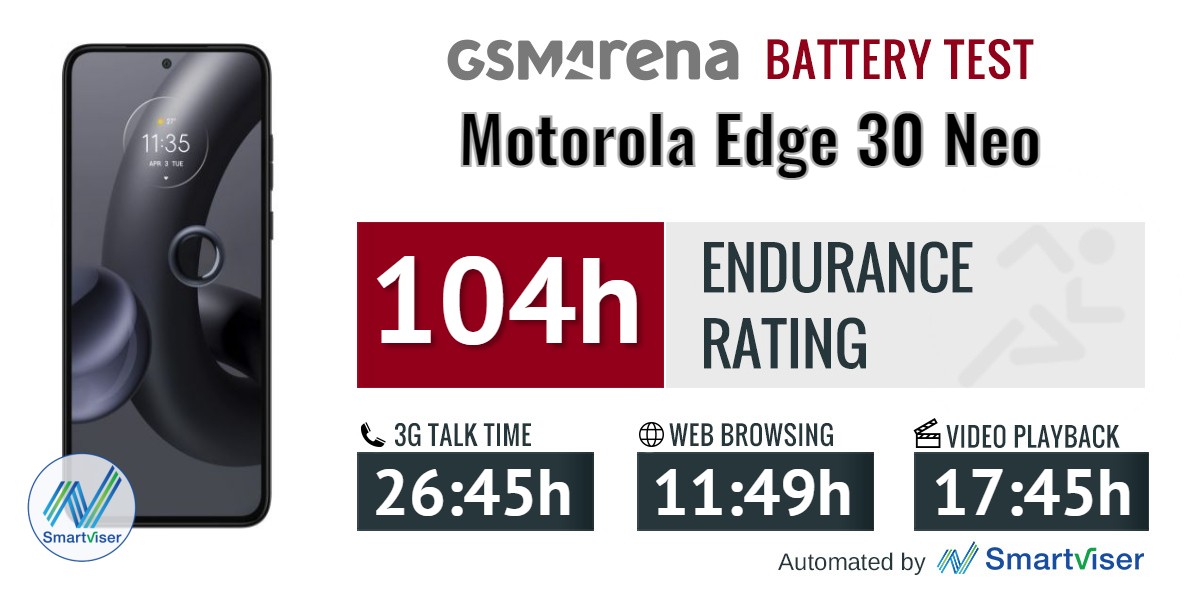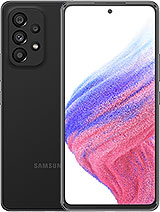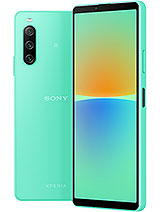Introduction and specs
The Motorola Edge 30 lineup came in two parts this year. From March through May, the company introduced the vanilla Edge 30 and Edge 30 Pro, whereas the Edge 30 Neo, Fusion, and Ultra arrived in the second half of the year with slightly different designs and brought a bit more to the table.
The subject of this review is the Edge 30 Neo, which is the most affordable of the bunch, but aside from the Snapdragon 695 SoC, the device comes off as a well-rounded device, which arrives in a market segment that's relatively unsaturated. Surely, there are quite a few alternatives price-wise, but the size of the Edge 30 Neo makes it somewhat unique.
Motorola Edge 30 Neo specs at a glance:
- Body: 152.9x71.2x7.8mm, 155g; glass front, plastic body; Splash and dust resistant.
- Display: 6.28" P-OLED, 120Hz, 1080x2400px resolution, 20:9 aspect ratio, 419ppi.
- Chipset: Qualcomm SM6375 Snapdragon 695 5G (6 nm): Octa-core (2x2.2 GHz Kryo 660 Gold & 6x1.7 GHz Kryo 660 Silver); Adreno 619.
- Memory: 128GB 6GB RAM, 128GB 8GB RAM, 256GB 8GB RAM.
- OS/Software: Android 12.
- Rear camera: Wide (main): 64 MP, f/1.8, 0.7µm, PDAF, OIS; Ultra wide angle: 13 MP, f/2.2, 120˚, 1.12µm, AF.
- Front camera: 32 MP, f/2.4, (wide), 0.7µm.
- Video capture: Rear camera: 1080p@30/60/120fps; Front camera: 1080p@30fps.
- Battery: 4020mAh; Fast charging 68W, Wireless charging.
- Misc: Fingerprint reader (under display, optical); NFC; stereo speakers.
There aren't many compact phones to choose from, especially in the mid-range class, so the Neo is a breath of fresh air of sorts. And it's also running quite capable hardware. The 6.28-inch, 120Hz OLED display is not only fast but bright as well. Memory configurations start at 6GB/128GB, the main camera is 64MP with OIS, and the secondary ultrawide camera uses a much-appreciated 13MP sensor instead of the overused and underwhelming 8MP one.
There's also a pair of stereo speakers, an under-display fingerprint reader and a respectable 4,020 mAh battery supporting not only 68W fast charging but also wireless charging. For some, 4,020 mAh capacity might not sound a lot, but as it's the case with compact smartphones, some compromises are needed, and battery capacity is often the first to go.

In addition to the rare features in the budget class outlined above, the Edge 30 Neo is one of the few devices running a clean Android OS. This has always been a key selling point for Motorola phones, so you can add that to the list of advantages as well.
It's evident that the Edge 30 Neo wants to stand out from the crowd with more than just a couple of quirky features. On paper, the Neo should appeal to anyone looking for a compact phone with pure Android. Still, Motorola's competitor holds several key hardware advantages over its rivals, and we take a deeper dive into the next pages to see if it's worth your hard-earned money.
Unboxing the Motorola Edge 30 Neo
The Motorola Edge 30 Neo comes in eco-friendly packaging with seemingly recycled paper. It holds the usual set of user manuals, a wall charger rated at 68W and a USB-C to USB-C cable for data transfer and charging.

There's also a transparent, hard case instead of your regular soft silicone covers that OEMs usually ship with their phones.
Design and ergonomics
The new Edge 30 trio sports a different design from the first duo released earlier this year, with the camera bump being the most notable change. It's now rectangular-shaped with oval edges. The main camera sits on a matte surface, while the ultrawide camera sits behind glossy glass. The bump isn't obtrusive, either.

Notably, the camera island has an LED strip around it, serving as an LED notification light. It's also indicating the charging status of the phone. That's pretty neat, and paired with the transparent case in the box, the LED illuminates the sides of the phone, so the LED is visible from the front too.

The Neo comes in four colors - Black Onyx, Ice Palace, Aqua Foam and Very Peri Purple, which is the color we got. Since this is the most affordable of the bunch, it's not made of glass or metal, but the back side features a pleasant matte finish. It makes it obvious that it's not glass, although we doubt that this was Motorola's intent in the first place. The OEM went for a grippy surface more than anything else, and we like it. The phone sits securely in the palm, and it's decently grippy.

Moreover, the device has manageable dimensions, to put it mildly. The device's chassis is just 7.8mm thick; it's only 152.9mm long and 71.2mm wide and tips the scale at just 155g. It's so lightweight and easy to handle that it's the first thing we noticed as soon as we grabbed the phone. Sure, the back panel forms a noticeable ridge where it meets the side frame but let's not get too picky.

The front panel, on the other hand, is flat with sharp edges around the side. The bezels are impressively thin, given the price tag of the device. The top and side bezels seem almost identical, while the bottom one is ever so slightly thicker. The cutout for the selfie camera is unobtrusive.
Moving over to the side frame, we find the volume rocker and the power button placed on the right side, with the latter being just within the thumb's reach while the former requires just a little bit of stretch. The bottom houses the USB-C connector, SIM card tray and the loudspeaker grille.
We didn't like the fingerprint reader placement, though - it's too close to the bottom edge of the screen, and you have to do some awkward finger gymnastics to place your thumb properly.

Still, we think the overall design and ergonomics are great. The handset may not have the best choice of materials, but it's lightweight, compact and has a nice, grippy surface. It's a great device to hold and operate with just one hand.
Flagship-level OLED panel
The Motorola Edge 30 Neo features a compact 6.28-inch P-OLED screen running at a 120Hz refresh rate. Although this display sounds like any other on paper, it's quite impressive, considering the device's price point.

In manual mode, we got up to 489 nits of maximum brightness, but in manual mode, the panel peaked at a whopping 1,004 nits. To put things into perspective, some considerably more expensive devices, flagship phones at that, don't go up to 1,000 nits. We are pleasantly surprised to see Motorola using such a high-quality OLED panel for its budget device.
| Display test | 100% brightness | ||
| Black, |
White, |
||
| 0 | 485 | ∞ | |
| 0 | 685 | ∞ | |
| 0 | 516 | ∞ | |
| 0 | 946 | ∞ | |
| 0 | 499 | ∞ | |
| 0 | 1047 | ∞ | |
| 0 | 489 | ∞ | |
| 0 | 1004 | ∞ | |
| 0.395 | 470 | 1190:1 | |
| 0.496 | 600 | 1210:1 | |
| 0 | 505 | ∞ | |
| 0 | 876 | ∞ | |
| 0 | 427 | ∞ | |
| 0 | 830 | ∞ | |
| 0 | 449 | ∞ | |
| 0 | 636 | ∞ | |
| 0 | 433 | ∞ | |
| 0 | 613 | ∞ | |
Color accuracy is also great in the Natural color mode achieving average dE2000 of just 1.2 within the sRGB color space. Whites and grays lack that typical blue-ish tinge, which is great.
HRR control
The refresh rate control is quite simple, and Motorola has been using this logic ever since their first HRR phone came around. If you are not interacting with the display, it dials down to 60Hz, and it will do so in video player apps such as Netflix and YouTube as well.
To our surprise, most third-party apps ran at 90Hz instead of 120Hz. We've only seen the maximum refresh rate in system menus and a couple of system apps. The easy workaround is to set the display at static 120Hz, but that would ask more of the battery as the screen will run at 120Hz at all times.
Battery life
Although the battery capacity is just 4,020 mAh, the results from our tests are not bad. In fact, the video playback test returned an impressive score along with the standby test. The web browsing test and the 3G call one were both rather low, which is understandable given the limited battery capacity.

Our battery tests were automated thanks to SmartViser, using its viSerDevice app. The endurance rating denotes how long the battery charge will last you if you use the device for an hour of telephony, web browsing, and video playback daily. More details can be found here.
Video test carried out in 60Hz refresh rate mode. Web browsing test done at the display's highest refresh rate whenever possible. Refer to the respective reviews for specifics. To adjust the endurance rating formula to match your own usage patterns check out our all-time battery test results chart where you can also find all phones we've tested.
Still, an overall endurance score of 104h is respectable given the size of the handset. it's nearly impossible to fit in a 5,000 mAh battery in this small body to compete with larger phones, so some compromises were made. Obviously, the 104-hour score falls a bit short of the competition, which often runs bigger batteries with bigger screens.
Charging speed
A combination of not particularly big battery and fast charging ultimately results in blazing-fast charging times. Don't get us wrong, though, the Edge 30 Neo has a 6.28-inch screen, so we can't expect the usual 5,000 mAh cell we see on much bigger phones.

Anyway, the device relies on a 68W charger working over the USB Power Delivery protocol. The device charged from 0 to 100% in just 40 minutes, while the first 30 minutes got 92% of the juice back. Excellent results.
30min charging test (from 0%)
Higher is better
- OnePlus Nord 2T
99% - Motorola Edge 30 Ultra
95% - Motorola Edge 30 Neo
92% - Motorola Edge 30 Pro
85% - Motorola Edge 30 Fusion
82% - Realme 9 Pro+
77% - Poco X4 GT
75% - Samsung Galaxy A53 5G
45% - Google Pixel 6a
42%
Time to full charge (from 0%)
Lower is better
- OnePlus Nord 2T
0:32h - Motorola Edge 30 Ultra
0:33h - Motorola Edge 30 Neo
0:40h - Realme 9 Pro+
0:49h - Motorola Edge 30 Fusion
0:52h - Motorola Edge 30 Pro
0:53h - Poco X4 GT
0:57h - Samsung Galaxy A53 5G
1:24h - Google Pixel 6a
1:51h
Speakers
The Edge 30 Neo features a set of stereo speakers in the usual configuration - a bottom-firing one and a loudspeaker on the top that also takes the role of an earpiece. To our surprise, this particular setup is quite balanced as there's minimal difference in loudness between the top and bottom speakers. Overall loudness is also good - we got -26.4 LUFS.
Sound quality is more than decent as well. The highs start to ring a little at higher volumes, but vocals are generally clean, and bass is slightly above average compared to smartphones with a similar setup.
Use the Playback controls to listen to the phone sample recordings (best use headphones). We measure the average loudness of the speakers in LUFS. A lower absolute value means a louder sound. A look at the frequency response chart will tell you how far off the ideal "0db" flat line is the reproduction of the bass, treble, and mid frequencies. You can add more phones to compare how they differ. The scores and ratings are not comparable with our older loudspeaker test. Learn more about how we test here.
Pure Android 12 experience
With Android 13 already out and about, we are a little bit disappointed to see Android 12 on board. Even if it gets it soon enough, we doubt that the handset will receive Android 14 once it comes around since mid-range devices usually settle for one major update.

However, you still get the benefit of using a clean Android, and lots of people are after that. It's lightweight, it's familiar, and it's stripped of the heavy UI customizations. Still, Motorola includes a couple of unique features typically found in all smartphones from the company.
Even with the Snapdragon 695 on board, the device runs well with little to no hiccups and slowdown. In fact, we feel that the Edge 30 Neo runs considerably smoother than other Snapdragon 695-powered handsets with custom Android skins.

The UI and overall appearance are close to stock Android. That includes the new pill-shaped quick toggles in the notification shade. And once again, it does not include the toggle for automatic brightness, and you have to dig deep into the settings menu to enable or disable the feature.








Home screen, recent apps, notification shade, settings menu
No change in the recent apps menu that displays apps in a carousel formation and no change in the app drawer as well. The iconography in the general Settings menu has been revamped, though, so it might take some time to get used to.
As is usually the case, Motorola has added a handful of useful extras. They are all placed in a Moto settings app that lists them in categories. The first one is Personalization, and allows you to tinker with fonts, app icons layout, accent colors, icon shape and themes.
The more useful additions, however, involve gestures. The iconic ones - karate chop for turning on the flashlight or twisting your wrist to open up the camera app are here. There's also the Power touch (double tap on the power button) that brings out an additional app panel from the right edge of the display. It works exactly how the smart sidebar does in other Android skins.
The Attentive display keeps the screen on when the front camera detects a face looking at it so the display won't go dark when you are halfway through an article. Peek display lights up the lockscreen once the device senses you are close and you pick up the phone. It uses the proximity sensor and the accelerometer to detect motion. And in case there's a notification, you can just tap and hold on to the notification icon to see a quick preview of the text.




Gestures and attentive display
Last but not least, the volume rocker keys can be used to change tracks by holding down the volume up or down key.
A relatively new feature is the Overcharge protection toggle in the Battery menu. It will cut off charging once it detects that the phone hasn't been unplugged for three days straight and keep the battery charged at a much healthier 80%.
Introduced in 2021, Motorola's 'ready for' platform enables a multitude of use cases that put the phone in the center of a big-screen experience. Connecting a TV or a monitor allows you to get a Windows desktop-like environment, play a game on your phone, display it on the external screen, or even have a video chat on a larger display. It works just as Samsung's DeX.
The connection can be made with a cable - either with the 'ready for' cable (or another USB-C MHL Alt solution) or with a USB-C-to-C cable with a compatible monitor. Alternatively, you can connect wirelessly to a Miracast-capable display.
If you don't have a mouse and/or keyboard handy, the phone's screen can be used as a trackpad and/or keyboard.


Ready for Moto feature, trackpad
You can also use 'ready for' on a Windows-based PC - it runs within a window on your desktop. This is helpful when you want to run an Android app from your computer or multi-task between devices on just one screen.



The "Ready For" desktop environment
Lastly, we can't miss mentioning the fast and responsive fingerprint reader. Even with this low-end chipset, the device unlocks with a light and a brief touch of the scanner. As we've already pointed out in the Design section of the review, our only complaint is the high positioning of the reader.
We didn't even notice any big slowdown outside of launching some heavier apps, which took a bit longer than usual. The UI doesn't feel heavy on the eye, nor does it take a toll on the hardware with excessive effects or animations.
Synthetic performance
This isn't the first time we get to see Snapdragon 695 5G chipset in action. Despite the incremental numeric change in the name, the chipset is actually totally revamped, compared to the Snapdragon 690. Along with the newer, more powerful CPU cores and GPU, the chip boasts 5G connectivity and is based on a more modern 6nm manufacturing process by TSMC. This wasn't a thing in the older Snapdragon 690.

The main two Kryo 560 Gold (Cortex-A77) cores are replaced with Kryo 660 Gold (Cortex-A78) cores clocked at 2.2 GHz while the six energy-efficient Kryo 560 Silver (Cortex-A55) clocked at 1.7 GHz remain the same. There's only a change in the name, now called Kryo 660 Silver. The Adreno 619L GPU has been replaced with a full-fledged Adreno 619. The SD695 now supports faster LPDDR4X memory at 2133 MHz as well.
GeekBench 5 (multi-core)
Higher is better
- Motorola Edge 30 Ultra
4265 - Poco X4 GT
3719 - Motorola Edge 30 Pro
3658 - Motorola Edge 30 Fusion
3458 - Google Pixel 6a
2876 - OnePlus Nord 2T 5G
2694 - Realme 9 Pro+
2335 - Snapdragon 695 average
1993 - Motorola Edge 30 Neo
1964 - Samsung Galaxy A53 5G
1891
GeekBench 5 (single-core)
Higher is better
- Motorola Edge 30 Ultra
1276 - Motorola Edge 30 Pro
1196 - Motorola Edge 30 Fusion
1073 - Google Pixel 6a
1047 - Poco X4 GT
917 - Realme 9 Pro+
814 - Samsung Galaxy A53 5G
743 - Snapdragon 695 average
684 - Motorola Edge 30 Neo
670 - OnePlus Nord 2T 5G
493
AnTuTu 9
Higher is better
- Motorola Edge 30 Ultra
1074722 - Motorola Edge 30 Pro
941895 - Motorola Edge 30 Fusion
827929 - Poco X4 GT
747871 - Google Pixel 6a
712092 - OnePlus Nord 2T 5G
619610 - Realme 9 Pro+
416031 - Snapdragon 695 average
387789 - Motorola Edge 30 Neo
380818 - Samsung Galaxy A53 5G
379313
GFX Aztek Vulkan High (onscreen)
Higher is better
- Motorola Edge 30 Ultra
62 - Motorola Edge 30 Pro
60 - Google Pixel 6a
39 - Poco X4 GT
38 - Motorola Edge 30 Fusion
35 - OnePlus Nord 2T 5G
30 - Realme 9 Pro+
16 - Samsung Galaxy A53 5G
15 - Motorola Edge 30 Neo
12 - Snapdragon 695 average (1080p)
12
GFX Aztek Vulkan High (offscreen 1440p)
Higher is better
- Motorola Edge 30 Pro
45 - Motorola Edge 30 Ultra
43 - Google Pixel 6a
32 - Poco X4 GT
24 - Motorola Edge 30 Fusion
23 - OnePlus Nord 2T 5G
20 - Realme 9 Pro+
10 - Samsung Galaxy A53 5G
10 - Motorola Edge 30 Neo
8.2 - Snapdragon 695 average
8
GFX Car Chase ES 3.1 (onscreen)
Higher is better
- Motorola Edge 30 Pro
78 - Motorola Edge 30 Ultra
73 - Motorola Edge 30 Fusion
62 - Google Pixel 6a
51 - Poco X4 GT
46 - OnePlus Nord 2T 5G
42 - Realme 9 Pro+
23 - Samsung Galaxy A53 5G
19 - Snapdragon 695 average (1080p)
17 - Motorola Edge 30 Neo
16
GFX Car Chase ES 3.1 (offscreen 1080p)
Higher is better
- Motorola Edge 30 Pro
95 - Motorola Edge 30 Ultra
93 - Google Pixel 6a
66 - Motorola Edge 30 Fusion
63 - Poco X4 GT
52 - OnePlus Nord 2T 5G
51 - Realme 9 Pro+
27 - Samsung Galaxy A53 5G
23 - Motorola Edge 30 Neo
20 - Snapdragon 695 average
20
3DMark SSE ES 3.1 (offscreen 1440p)
Higher is better
- Google Pixel 6a
8808 - Samsung Galaxy A53 5G
3631 - Motorola Edge 30 Neo
2921 - Snapdragon 695 average
2273
3DMark SSE Vulkan 1.0 (offscreen 1440p)
Higher is better
- Samsung Galaxy A53 5G
3570 - Motorola Edge 30 Neo
2747 - Snapdragon 695 average
2139
As you can see, the Edge 30 Neo doesn't deviate a lot from the average Snapdragon 695 performance in our database, but it does fall short of pretty much all competitors in the same price bracket. We've picked only rivals priced within €50 of the Edge 30 Neo's retail price. There are phones with a lot more competent chipsets in this price range, such as MediaTek's Dimensity 8100 and 1300 or even the Dimensity 910. The Samsung Galaxy A53 with the in-house Exynos 1280 is the only one that drags behind the Snapdragon 695 in some of the tests.
No-nonsense camera setup
We must admit that it's refreshing to see a mid-range smartphone without useless macro and depth sensors and one that doesn't use the common 8MP ultrawide camera that desperately needs to be replaced with a different one.

The Motorola Edge 30 Neo has just two cameras on its back, both of which are usable. The main one uses a 64MP, 1/1.97", 0.7µm sensor and f/1.8, optically stabilized lens. The second one is a 13MP, f/2.2, 1.12µm camera with autofocus. The advertised field of view is 120 degrees.
The front holds a 32MP, f/2.4, 0.7µm camera that outputs 8MP binned photos.
Camera menus
The handset uses version 9 of Motorola's Moto Camera app, which is distributed and updated through Google Play. There are some small changes to the UI compared to the previous Moto devices we've reviewed but the general concept remains. Swiping left and right switches between camera modes while the additional ones are located in the "More" sub-menu on the far-right of the carousel.
Additional settings for each Photo or Video mode are accessed by a swipe down from the top of the viewfinder.
There's no 2x zoom toggle probably, you only get ultrawide, 1x and macro toggles on the viewfinder. Something tells us that even Motorola doesn't want you to zoom on your photos.
We are happy to report that Motorola has finally fixed the interpolation behavior and now the main and the ultrawide cameras shoot in their native resolutions. No needless upscaling this time around. We also like the dedicated toggle for the Macro camera. It finally gets a spot on the viewfinder in the default Photo mode.
Daylight samples
Main camera
During the day, the main camera delivers good photos with a wide dynamic range, great sharpness and plenty of fine detail. The foliage looks good, colors are punchy and there's hardly any noise. The overall photo quality is clearly up there with the Samsung Galaxy A53, which is one of the competitors in the price range.
The primary camera performance is very consistent both outdoors and indoors. Noise is a bit more visible indoors across surfaces of uniform color but you'd really have to pixel peep to notice it.
The 64MP mode is hard to recommend as noise, general softness and weird artifacts plague the photos. Dynamic range is worse too so the extra detail you'd get just isn't worth it.
Ultrawide camera
The ultrawide's quality is definitely above average as most phones in this price bracket rely on 8MP sensors and we get 13MP here. Of course, not everything boils down to the sensor resolution. The quality lens is important as well. The Galaxy A53 uses a 12MP ultrawide, for instance, but it produces much softer images for some reason but we suspect its lens is to blame. But we digress.
The ultrawide photos we took with the Motorola Edge 30 Neo have contrast on point, good color saturation, and very good fine detail for this sort of camera. The otherwise above-average sharpness was only compromised around the corners, where we could also see some purple fringing. These photos also have a more limited dynamic range than the main camera's resulting in crushed shadows here and there.
Overall, we are quite happy with the ultrawide camera's performance. The added bonus of having autofocus is a perk you shouldn't overlook. That's usually a feature reserved only for high-end phones. In fact, even big dogs like Samsung miss to include that in some of its flagships. The AF allows for dramatic close-up shots too.
Speaking of autofocus, it allows the camera to shoot macro photos and you can get a crisp focus on a subject 2-4 cm away. The results aren't amazing but they are way better than what we've seen from competing dedicated 2MP macro camera solutions.
Low-light samples
Main camera
The main camera's nighttime performance is quite decent - the photos come out well-exposed and with good color saturation. Thanks to HDR, highlights are well preserved too. Zooming in however reveals there is not much fine detail and shadows are often quite dark.
The Galaxy A53 does a better job with these photos with a sharper detail rendition, less noise and brighter shadows.
The Motorola Edge 30 Neo's Night mode is not very competent. Stacking frames took a bit too long every time and the results left us with mixed impressions. We certainly saw the noise reduced, the shadows considerably brightened and better detail rendition overall. However, these photos have a weird color reproduction, which looked unnatural and even a bit washed out. So in the end, we preferred the photos produced by the standard Photo mode.








Night mode main camera samples
Ultrawide camera
While the ultrawide does a pretty decent job during the day, it struggles to deliver usable photos at night. The images are quite colorful and have nice exposure but only as long as you view them on the phone’s screen. Any sort of magnification reveals they are in fact really soft and fine detail is smeared beyond recognition. There's no Night mode available for the ultrawide camera either.
The Samsung Galaxy A53 does a better job here with its ultrawide photos, producing sharper images with brighter shadows. It really left us wondering why its ultrawide has such a poor performance during the day.
And here are photos of our usual posters taken with the Motorola Edge 30 Neo. You can see how it stacks up against the competition.



Motorola Edge 30 Neo agaianst the Samsung Galaxy A53 and the OnePlus Nord 2T in our Photo compare tool
Portraits
The portrait shots are pretty good if the right lighting conditions are met. Under good sunlight, the photos have plenty of detail, color and display excellent sharpness. The latter seems to suffer the most indoors. The natural skin tone is preserved throughout all lighting conditions and the HDR keeps the subject's face always well exposed too.
The bokeh effect is quite convincing as the edge detection is doing a pretty good job of separating the subject from the foreground and background and can only be fooled by unruly hair.
The only issue we had was the process of taking a portrait photo - the software was not very reliable in detecting a person in the scene and often complained that our subject was too far away while the opposite was true.
Selfies
The selfies are colorful, with decent dynamic range and sharpness but noise can often be spotted on homogeneous backgrounds. There's not much fine detail and the subject's skin can often appear pale, especially if there's a strong light source nearby. The bokeh effect isn't amazing and can sometimes blur the edges around the subject.
Video recording
The smartphone caps at 1080p@60fps with EIS video recording, even when using its main camera. That's due to hardware limitations as the Snapdragon 695 chipset lacks a 4K-capable ISP. Sadly, that's a big omission as most of the Edge 30 Neo's competitors are capable of 2160p recording.
Let's begin with the 1080p@30fps video recorded by the primary cam. The videos are colorful and contrasty but the dynamic range is not at its best with some clipped shadows and highlights.
The ultrawide camera can also do 1080p@30fps videos and it produces about the same level of video quality with nice and punchy colors and a decent level of sharpness. The contrast is even higher here, which hurts the dynamic range a bit more but these videos are still good coming from an ultrawide cam.
Finally, here is the Motorola Edge 30 Neo in our video tool so you can make your own comparisons.



2160p: Motorola Edge 30 Neo (1080p) against the Galaxy A53 and the OnePlus Nord 2T in our Video compare tool
Competition
As we said earlier in the review, the Motorola Edge 30 Neo is a rare specimen and there are only a handful of direct competitors in the same price and size category at the same time. The Neo weighs just 155g and carries a compact 6.28-inch display. In addition to its size advantage over the competition, the handset is also a strange mixture of higher-end features and an affordable price tag - just €370. In some markets the phone is offered with Lenovo's Smart Clock 2, making it a tad more lucrative offer than some alternatives. It's quite evident that Motorola was trying to retain some of the premium features of the Edge series, yet we still have to look at the currently available alternatives.

One true competitor to Motorola's contender is the Pixel 6a. It checks all the boxes of a niche product - flagship (sort of) SoC, compact 6.1" screen diagonal, stock Android 13 and flagship-level camera performance. The handset also has a nice build with IP67 rating against water and dust. The display may not be as bright as the Edge 30 Neo’s and charging isn't exactly "fast", but it the Pixel 6a supports HDR and the battery lasts a little longer.
![]()


Google Pixel 6a • Samsung Galaxy A53 5G • Xiaomi Poco X4 GT
The Samsung Galaxy A53 is a tad cheaper and follows a similar concept. It has most of the Edge 30 Neo's features, but it's a bigger phone with Samsung's heavy One UI on top, less than ideal chipset and just 4GB of RAM as a standard. You can get it for about €40 less than the Neo, though, and you get longer battery life.



Realme 9 Pro+ • OnePlus Nord 2T • Sony Xperia 10 IV
While the Edge 30 Neo lacks in the chipset department and excels in most other areas, Xiaomi's Poco X4 GT sits on the other end of the spectrum. It doesn't have particularly impressive hardware except for the Dimensity 8100 SoC, which is quite potent in this price range. Charging is fast and battery life is more than decent, but display and overall camera quality fall short of Motorola's offering.
Sony took a similar approach here and tries to stand out in the segment with the Xperia 10 IV and its rare feature set. This phone is also relying on the underwhelming (for the class) Snapdragon 695 SoC, omits HRR on its OLED display and has a single, bottom-firing loudspeaker. On the other hand, Sony's contender is even smaller in size, didn't cut on battery capacity by offering a 5,000 mAh unit, has a telephoto camera, offers proper IP65/IP68 certification and has a microSD card slot in addition to the 128GB standard storage option. Moreover, the Xperia 10 IV asks about €400 and it's running on stock-ish Android, just like the Edge 30 Neo.

And two very similar phones from BBK Electronics might also be a good choice over the Edge 30 Neo - the Realme 9 Pro+ and the OnePlus Nord 2T. Motorola's advantages in design, ultrawide camera, display and software departments remain, but it's hard to deny the Realme 9 Pro+ and Nord 2T's more powerful chipsets, better main camera capabilities and longer-lasting batteries. Both are slightly cheaper, too.
Verdict
The Neo, in particular, impresses with an extremely bright and fast OLED panel, OIS on the main camera, better 13MP ultrawide camera with autofocus, blazing fast 68W fast charging, wireless charging, a set of nice-sounding stereo speakers and a nifty LED strip around the camera used for notifications and other stuff. Of course, some compromises had to be made, so Motorola settled for a Snapdragon 695 SoC. Most of Neo's competitors run on faster chipsets and support 4K video recording. The device's camera capabilities, although not inherently bad, are not particularly impressive, leaving an easy opening for alternatives with better camera performance.

The good news is that the clean, burden-less Android experience doesn't slow down the chipset and operation is quite fluent and trouble-less.
So, if you are willing to make some compromises in terms of raw performance and overall camera performance, the Motorola Edge 30 Neo gives you a whole lot of reasons to like it.
Pros
- Outstanding 120Hz OLED display
- Lightweight and compact body with water-repellent design, LED notification ring.
- Good-sounding stereo speakers.
- Clean and snappy Android experience.
- Blazing fast charging, wireless charging.
Cons
- Phones with better-performing chipsets are available in the price segment.
- The camera Night mode is not very competent, no 4K video recording.
from GSMArena.com - Latest articles https://ift.tt/Cd9KM2t
via IFTTT
Bagikan Berita Ini

































































































0 Response to "Motorola Edge 30 Neo review"
Post a Comment